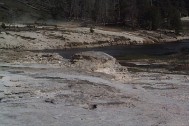One of the first things I noticed at Giant was the amount of erosion in two areas. In the first, the edge of the platform northwest of Feather and the rest of the sputs has been eaten back by what seems to be over a meter in places. This area of fresh, unweathered sinter is distinctly terraced.
Over by Catfish, the whole front of the base of its cone also shows fresh, laminated sinter which, I would assume, is being exposed and undermined by the action of Mastiff during both eruptions and hot periods.
If this is what frequent activity over a few years time can do, the the question, it seems to me, becomes, how long until a major change in one of these features occurs because of this erosion. One of the sput vents could have it's rim dropped by several centimeters. The whole southwest side of Catfish could be opened up and exposed, turning it into another breached cone just like Giant.
Another possibility is that the deposits within the actual vent of Catfish do not have the horizontal laminations characteristic of all the erosion going on, and thus will be more resistant to the attack on it.
Perhaps erosion plays a larger part in the formation of cones than is realized. A feature builds up a modest raised vent in the middle of a larger, flat platform. Then another feature erodes away those horizontal platform deposits, leaving the vent's vertical deposits intact. The second feature subsides, allowing the first feature to continue to build deposits on its cone, but now outside over the newly exposed platform. Eventually, it might be difficult to determine that the platform was ever much higher, and the cone not as tall.
A perfect example of this is not far away: Turtle. Note how the turtle shaped cap is sitting on a horizontally laminated pedestal. If it were to reactivate and begin depositing over the entire structure, evetually those laminations would be hidden and instead we would see a tall cone there.


